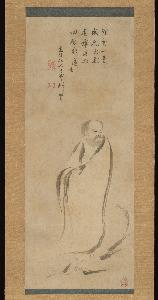Kano Genshun
Kano Genshun;Genshun
Place: Kyoto
Born: 1596
Death: 1656
Biography:
Kano Genshun was a Japanese painter of the Kanō school, born in Kyoto in 1596. He was the son of Kanō Takanobu and the grandson of Kanō Eitoku, making him a part of a long line of renowned painters. After his father's death in 1618, Genshun became the head of the Kyoto branch of the Kanō school.
Artistic Style and Career
Genshun was known for his skill in painting figures and landscapes, which were characteristic of the Kanō school style. This style, also known as the Kanō school style art movement, was one of the most famous schools of Japanese painting, with a history that spans from the late 15th century to the Meiji period. The school was founded by Kanō Masanobu and produced a string of major artists over several generations. Genshun's work can be found in various museums and collections, including the Shimane Art Museum, which features works by other notable Japanese painters such as Ike Taiga. His paintings often featured natural subjects such as birds, flowers, and trees, showcasing his mastery of traditional Japanese painting techniques.
Notable Works and Legacy
Some of Genshun's notable works include paintings of landscapes and figures, which demonstrate his skill in using Chinese-inspired ink wash and vibrant color palettes. His work is characterized by strong outlines, bold colors, and extensive use of gold leaf, creating a visual impact that was both impressive and luxurious. Genshun's legacy can be seen in the many artists who followed in his footsteps, including Kano Tan'yū, who was also a prominent painter of the Kanō school. The Kyoto branch of the Kanō school continued to produce high-quality paintings, with Genshun's contributions playing a significant role in shaping the school's style.
- Visit Kano Takanobu's Meeting between Emperor Wen and Fisherman Lü Shang to see an example of Genshun's father's work.
- Explore the Kano Genshun page on Wikioo.org to learn more about his life and works.
- Discover the Kanō school style art movement and its history on The Kanō School Style Art Movement page.
Genshun died in Kyoto in 1656, leaving behind a legacy of beautiful paintings that continue to inspire artists and art lovers today. His work can be found in various museums and collections, including the National Museum of Japanese History, which features an extensive collection of Japanese art and artifacts.

